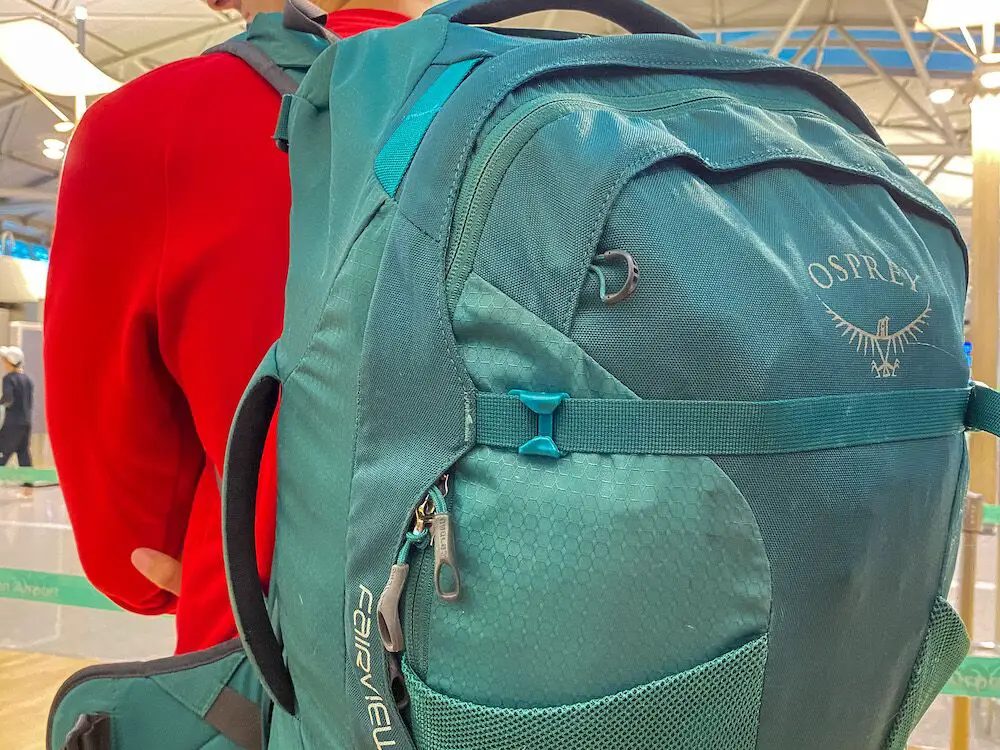There are several types of baggage in air travel.
But the two basic baggage types are checked baggage and carry-on baggage. It’s important to understand the difference between the two. In addition to that, it’s beneficial to know about the other baggage kinds as well.
Read on to learn more about types of bags allowed on planes.
Did you miss a connecting flight? File a compensation claim online.

Understanding the Different Types of Baggage in Air Travel
So, what are the different types of luggage on a plane?
1. Checked Baggage
Checked baggage is the type of luggage that is transported in the cargo hold of the plane. It is collected by an airline as passengers check-in at the airport. These bags are then loaded onto the aircraft. Checked baggage comes with a weight and size limit and is often charged as an additional fee.
If you are booking a flight with a full-service traditional airline, checked baggage allowance may be included in the ticket price. Keep in mind that every airline has its own checked baggage policy and weight/size restrictions.
Checked baggage is often called hold baggage.
Read more:
2. Carry-On Baggage
This is the most common type of baggage in air travel.
This is the bag that passengers carry onto the aircraft with them. It is smaller and lighter than checked baggage, and passengers can usually stow it in the overhead compartments or under the seat in front of them.
Passengers are limited to the number of bags they can carry. Usually it’s one carry-on bag per person. Remember that every airline has its own carry-on baggage policy and weight/size restrictions.
Carry-on baggage is often called cabin baggage, or carry on.
Read more: What is Carry-On Baggage?
The main difference between checked baggage and cabin baggage is that checked baggage is transported in the cargo hold of the plane, while cabin baggage is kept in the cabin with the passengers. Passengers have more control over their cabin baggage, as they can easily access it during the flight. This makes it convenient for passengers to keep important items such as documents, medications, books laptops and other electronics close at hand.

Other Types of Baggage on a Plane
Carry-on bag and checked baggage are two main types of baggage in flight. However, there are 3 more kinds of baggage you should know about.
3. Personal Item
A personal item is a small bag or item that passengers can bring with them on board, alongside their carry-on baggage. Unlike carry-on luggage, which is typically stored in the overhead compartments, a personal item is usually placed under the seat in front of the passenger.
During a flight, personal items provide extra storage space for essential items you may need to access easily.
Personal items can include a purse, laptop bag, briefcase, small backpack, or camera bag. The size and weight limits for personal items may differ depending on the airline, but they usually need to be smaller and more compact than carry-on bags.
Some budget (i.e., low-cost) airlines such as Ryanair, Wizz Air, easyJet, etc., permit only one free personal item per passenger. If you wish to bring a carry-on bag, you will need to pay an additional fee.
It is essential to pay attention to the luggage restrictions when booking a flight. This will help prevent any unexpected surprises later on.
4. Special Baggage
This type of baggage includes items that require special handling, such as strollers, sport equipment, wheelchairs, and musical instruments. Special baggage can also include items that are fragile, bulky, or require special handling, such as artwork, antiques, and medical equipment.
Passengers will need to notify the airline in advance of their intention to bring special baggage. Special baggage also comes with an additional fee.
5. Excess Baggage
If a passenger exceeds the limit for check-in or carry-on baggage, they will need to pay an additional fee for the excess. Excess baggage fees vary depending on the airline, and passengers are advised to check with their airline for the specific policy.
Do you have more questions about these types of baggage? Ask in the comments. What kind of bag do you travel with? Do you travel with a checked bag? Or prefer to travel with a carry on bag only?
About the author:
Una is an organized globetrotter and foodie who’s been living a digital nomad lifestyle since 2013. She always starts her day early with a good book before diving into work. Apart from traveling and aviation, her other passions include gym, hiking and cycling. Una is also a strong proponent of AI technology. She firmly believes in its potential to simplify life and has often advocated for its wider adoption in our day-to-day activities. Her favorite airlines are Qatar Airways, Emirates, and KLM.
